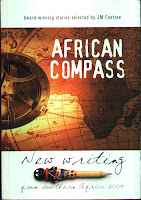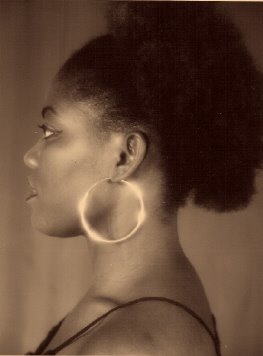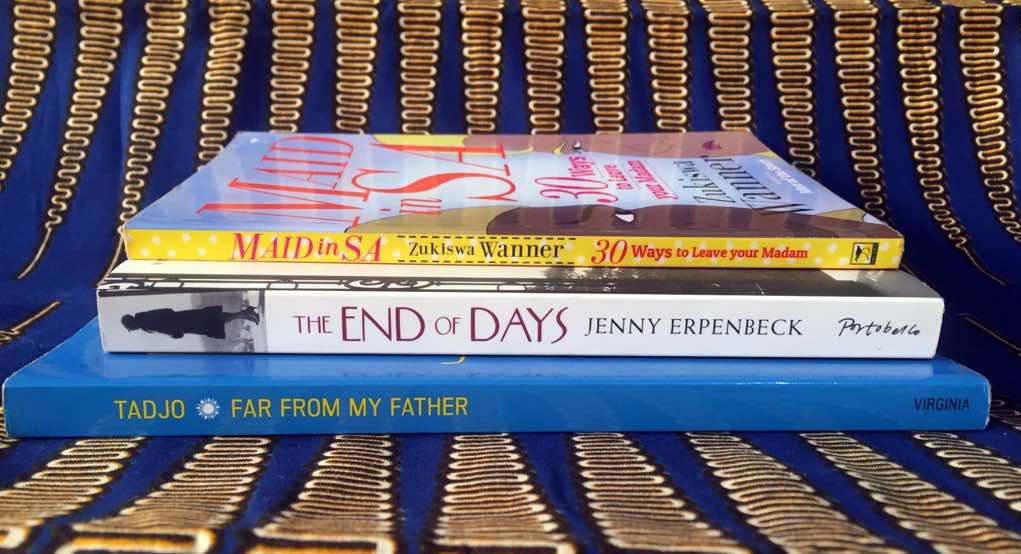
Nike Adesuyi - Poet
My books of the year are Seeing Double by Patrick Wilmot and Wole Soyinka's You Must Set Forth At Dawn. I love Seeing Double (Jonathan Cape) for its expansive, swashbuckling, hard-hitting narrativity and activist- historicity - not to mention its hilarity. I found it very educative, enlightening and intellectually stimulating.
You Must Set Forth At Dawn: I love it because it's, well, a Soyinka book - Yes! But more to the point because, it unlayers and humanifies the mythical Soyinka. Plus it’s full of the intoxicating Soyinkaesque turn-of-phrases that gave me a delightful buzz.
Chimamanda Ngozi Adichie - author of Half of a Yellow Sun
I haven’t read much fiction published this year; MG Vassanji’s The In-Between World of Vikram Lall (Canongate; 2004) was not published this year but is the work of fiction I most enjoyed. Elegantly-written from the point of view of a Kenyan man of Indian descent, it casts a clear and honest eye on race and nationalism in Kenya while never forgetting that the soul of a novel is character and emotion.

Ayi Kwei Armah’s The Eloquence of the Scribes (Per Ankh; 2006) stimulated me in the most wonderful way: whether I was nodding in agreement or fiercely disagreeing, I was always applauding. And I did not think I would enjoy an anthology called Outsiders Within, Writings On Transracial Adoption (South End Press, 2006) as much as I did. It is a collection of writing by people adopted transracially and to be let into their worlds was eye-opening and moving.
Afam Akeh - author of Letter Home
I expect to be lost in a long queue of readers choosing Chimamanda Ngozi Adichie’s Half of a Yellow Sun as one of their memorable books of 2006. This popularity of the novel is hung on three factors, each as important as the other: It is a well written story, on a memorable, still controversial, historical subject, and both writer and book are well exposed by their handlers. This author enjoys the level of publishing support most other emergent and even established Nigerian writers may only dream about. Extensive professional support in the editing, scheduling,
 placement and promotion of her work means that Adichie has a huge impact on critics and readers of her work. But her good fortune with the publishing process is sustained by the fact that there is also excellence and integrity in her writings, demonstrated now over two novels and other shorter pieces.
placement and promotion of her work means that Adichie has a huge impact on critics and readers of her work. But her good fortune with the publishing process is sustained by the fact that there is also excellence and integrity in her writings, demonstrated now over two novels and other shorter pieces.There is a Biafran scar in the memory and conscience of the world. As the subject of fiction, it is a gift in the hands of any competent writer – and competence is what Adichie triumphantly demonstrates all through this searching investigation of the weaknesses of the human heart, and failure in human purpose. In Adichie, humanity may not quite be the utterly doomed project of some Grecian tragic vision, but the human is certainly for her a flawed being, with every life its blemish. In what does become a committed search for failure even in the lowly human (no fantasies of perfectly obedient and powerless servants here), Adichie’s authorial eye is unsparing. Sisters Olanna and Kainene, and the men in their lives, those distracted moments of intellectual banter in the narrative, the mature, unemotional mapping of treachery and conflict in human
 relationships – Adichie makes them live in the memory of her readers. And there are still the carefully selected and planted images and echoes of a war without winners, all the plot-thickening and other cinematic devices by which this narrative begs for some stage or screen – such evidence of due labour in the writing that finally reveals Adichie as deserving of every support and respect accorded her. What else would I like to see? Adichie, engaging more with ideas. The truly great novelists of history were not merely outstanding artists; they were quite often also remarkable visionaries.
relationships – Adichie makes them live in the memory of her readers. And there are still the carefully selected and planted images and echoes of a war without winners, all the plot-thickening and other cinematic devices by which this narrative begs for some stage or screen – such evidence of due labour in the writing that finally reveals Adichie as deserving of every support and respect accorded her. What else would I like to see? Adichie, engaging more with ideas. The truly great novelists of history were not merely outstanding artists; they were quite often also remarkable visionaries.Jude Dibia - author of Walking With Shadows
Half of a Yellow Sun by Chimamanda Ngozi Adichie: Seldom has a writer been able to capture the essence of a gloomy time like Adichie does with this, her second book. I bought a copy from London Heathrow Duty Free on my way to Boston in October and before the six hours flight was over I had already covered more than half of this epic book. Adichie has been able to recapture a history that Nigeria still pretends never happened and she has done so wi
 th memorable characters. I will not forget in a long time Ugwu, Olanna, Odenigbo, Richard, Kainene and the other rich characters that made this book thoroughly enjoyable yet haunting.
th memorable characters. I will not forget in a long time Ugwu, Olanna, Odenigbo, Richard, Kainene and the other rich characters that made this book thoroughly enjoyable yet haunting. 26a by Diana Evans (Chatto & Windus, 2005): Diana Evans' debut novel about two very different twins and the changes they go through when growing up and dealing with life and its issues, was very enjoyable. In a style almost similar to Toni Morrison, she captures the psychological tearing apart of these two women and the tragic event that took place in Nigeria that was to lead to the eventual demise of one of them. This was a very strong novel with deep and thought provoking themes that left me breathless at the end.
Uche Nduka - author of Heart’s Field
Half of a Yellow Sun (Knopf, 2006) by Chimamanda Ngozi Adichie: This marvellously researched book deals audaciously with the Biafra
 some of us lived in as children. No detail is spared by the writer to interrogate the history and the wasted lives and dreams of a period (1967 - 1970) in Nigeria's existence that is still (officially?) murky. Adichie's descriptive and empathic prowess is evident on almost every page of this important book. The transformation of painful facts - hunger, genocide, propagandistic deceits, mercenary interventions - into a novelistic context is what I find very laudatory in this sometimes emotional text.
some of us lived in as children. No detail is spared by the writer to interrogate the history and the wasted lives and dreams of a period (1967 - 1970) in Nigeria's existence that is still (officially?) murky. Adichie's descriptive and empathic prowess is evident on almost every page of this important book. The transformation of painful facts - hunger, genocide, propagandistic deceits, mercenary interventions - into a novelistic context is what I find very laudatory in this sometimes emotional text.Where The Stress Falls (Vintage; 2006) by Susan Sontag: Sontag's essays are a surge of words in the service of her brilliant search for genuineness in life, art, politics. She relishes independence, outspokenness, stylistic restlessness, and a penetrative imagination. Her observations on writers as varied as Marina Tsvetaeva, Elizabeth Hardwick, Joseph Brodsky, Witold Gombrowicz, Roland Barthes, Danilo Kis, Borges and others, are consequential counsels on what it takes to remain committed to the vocation of writing. She relentlessly battles against cultural myopia, literary cowardice, communal cant, self-pity and traduced eros. I recommend this book as a very indispensable one towards aiding the ongoing global efforts to establish a serious, enduring, sincere and inclusivist aesthetic in art.
Wale Okediran - author of Strange Encounters
 From Prisoner to President: The Political Metamorphosis of Olusegun Obasanjo (New Deal Publications, Nigeria; 2005) by Femi Ademiluyi - is an account of the odyssey of an intriguing man and his transformations - from Warlord to Democrat; Military ruler to Critic of military rule; and from Prisoner to President. The author, the "unabashed admirer" he calls himself, has produced a "friendly biography" - perhaps a too friendly one - sprinkling his subject with last doses of adulation as: ‘a honest man’, ‘a reluctant leader’, and ‘a prominent African elder statesman’. Nevertheless, it is a highly readable and well researched contribution to Nigerian history. Once in a while though, the author strains too hard to eulogise his subject. His comparison of Obasanjo to great leaders like Nelson Mandela, the great American hero Douglas McArthur as well as Franklin D. Roosevelt may not go down well. Regular references to Obasanjo as a ‘true democrat’ and ‘a man of the people’ totally contrast with the President’s well known Machiavellian attitude of using disingenuous methods to achieve power and success. It is good that Ademiluyi concluded the accounts of his subject on May 29, 1999, when Obasanjo became the president of Nigeria. Had he gone further, it is not likely the author would have been able to produce such ‘a friendly biography’ and for this, the subject should be thankful.
From Prisoner to President: The Political Metamorphosis of Olusegun Obasanjo (New Deal Publications, Nigeria; 2005) by Femi Ademiluyi - is an account of the odyssey of an intriguing man and his transformations - from Warlord to Democrat; Military ruler to Critic of military rule; and from Prisoner to President. The author, the "unabashed admirer" he calls himself, has produced a "friendly biography" - perhaps a too friendly one - sprinkling his subject with last doses of adulation as: ‘a honest man’, ‘a reluctant leader’, and ‘a prominent African elder statesman’. Nevertheless, it is a highly readable and well researched contribution to Nigerian history. Once in a while though, the author strains too hard to eulogise his subject. His comparison of Obasanjo to great leaders like Nelson Mandela, the great American hero Douglas McArthur as well as Franklin D. Roosevelt may not go down well. Regular references to Obasanjo as a ‘true democrat’ and ‘a man of the people’ totally contrast with the President’s well known Machiavellian attitude of using disingenuous methods to achieve power and success. It is good that Ademiluyi concluded the accounts of his subject on May 29, 1999, when Obasanjo became the president of Nigeria. Had he gone further, it is not likely the author would have been able to produce such ‘a friendly biography’ and for this, the subject should be thankful.
African Compass – Award-winning Stories from Southern Africa selected by JM Coetzee (Spearhead, SA; 2005): The book is the first produced as part of the three-year series of HSBC/SA PEN Literary Award. The targets are young writers who from countries in the Southern African Development Community. According to Nobel Laureate Coetzee: "There is a rich variety amongst the 26 stories." Some stories still bore the marks of school classroom, others were obviously by seasoned hand. Some were sophisticated in style, drawing confidently on the extravagances of contemporary postcolonial fiction, others were still following faithfully the example of Somerset Maugham.
Expectedly, many stories reflect apartheid SA in their themes; Violence, Rape, Racial discrimination spiced with occasional love stories. One is captivated by powerful narrations, tension and the quality syntax which keep the reader glued to the book. However, the pessimism, hopelessness and depression that emerge from the mostly sad stories may not be well appreciated by readers outside SA. The story of rape in "Pictures" by Tebago C Sengfend and that of utter hopelessnes in "Despair" by Bruce Leech are typical examples of the kind of stories that grace the pages of this wonderful collection. In "Pius" by Elizabeth Ann Pienaar, we are led through the thoughts of a man who was shot by armed robbers as he lay dying from the gunshot wounds, while Hum Morris in "The Trucker and the Trucker’s Wife" related the death of a driver and his wife in an auto accident. Good as the collection might read, the question is whether these stories truly reflect today’s South Africa.
- Compiled by Molara Wood; First published 28 January 2006
- Books of Last Year 1











.jpg)





3 comments:
Where's mine Molara?
I sent you a mail about Osundare.
Be well.
Patience is a virtue, Igwatala. Especially for writers.
I got your mail about Osundare.
MW
great.
Post a Comment